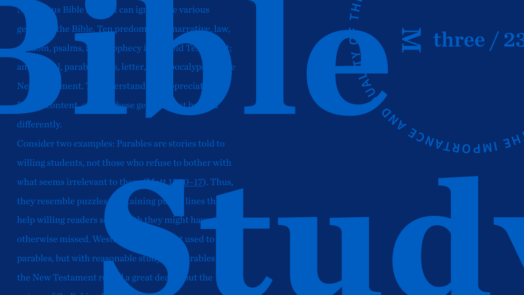If Revelation were the first book of the Bible you read, you’d be very confused. Chronologically, it comes last. But what about the other books of the Bible? They’re not in order by date. (Most scholars believe Mark was written before Matthew, for...
Studying the Bible is not as hard as it might seem—in fact, there are so many benefits that the task can quickly become a joy. Through Bible study, we draw closer to the Author of our faith, begin to discern his voice as he speaks to us in a deeply...
Every month, around 350 people search for “Bible reading plans PDF.” Nearly 12,000 people on average (and as many as 30,000!) search for “Bible reading plans” monthly. Here’s a great (free) option for every one of those people—and you too. Here’s...
The Bible is a big book. So big that fully understanding it remains a lifelong goal. Rather than trying to read it through in a few sittings, like most of us do with many smaller books, many people instead read a small amount every day. The slow-and...
Kristen Schafer discusses how your church community can grow closer using Faithlife Groups (0:10), and Todd Bishop teaches you how (and why) to use Bible reading plans in Logos (2:05). Grow with your church through Faithlife Groups Faithlife Groups...
When you think about helping people grow spiritually, Bible engagement and discipleship are probably at the top of your list. What if your congregation engaged with the Bible in meaningful ways every day?
Kristen Schafer shares how she uses Logos reading plans to stay connected with friends throughout the country (0:10), and Todd Bishop shares how to use Exegetical Guides in Logos (4:05). Access Reading Plans in Logos—free Both of the features...
You can set Logos to remind you to read any resource in your library. Generate a custom reading plan from the Docs menu to get started. Choose from a predefined plan, generate a scheduled plan for a given text, or fully customize your own plan...
As the novel coronavirus continues to spread, it’s not only impacting church gatherings across the nation (many are scrambling to get their churches online fast), but some states are shutting down everything except groceries, pharmacies, and take...
The start of a new year invites us to stop and reflect, doesn’t it? We think about the healthy habits we need more of . . . and the unhealthy ones we need less of. About balance and healthy rhythms. As I thought through how to achieve a healthier...
The start of a new year invites us to stop and reflect, doesn’t it? We think about the habits we need to create . . . and the ones we need to leave behind for good. As I thought through how to achieve a healthier year, just one powerful resolution...
I was talking with a friend recently about how I’d been spending a lot of time reading books about the Bible, but less time reading the Bible itself. The spaces between my personal reflections on Scripture were growing wider. I still felt like...
Faithlife Bible reading plans take the guesswork out of daily Bible reading—no more wondering what you should read next. Choose a reading plan and save time for the important part—reading, understanding, and living out the Scriptures. The Bible is...
Today's post is from Morris Proctor, certified and authorized trainer for Logos Bible Software. Morris has trained thousands of Logos users at his two-day Camp Logos seminars and provides many training materials. Several people have e-mailed me...
The new year is upon us—a time for making resolutions and setting goals. What better way to start 2012 than with a new Bible reading plan? Following a Bible reading plan is an easy way to become more familiar with the Scriptures—one day at a time...















